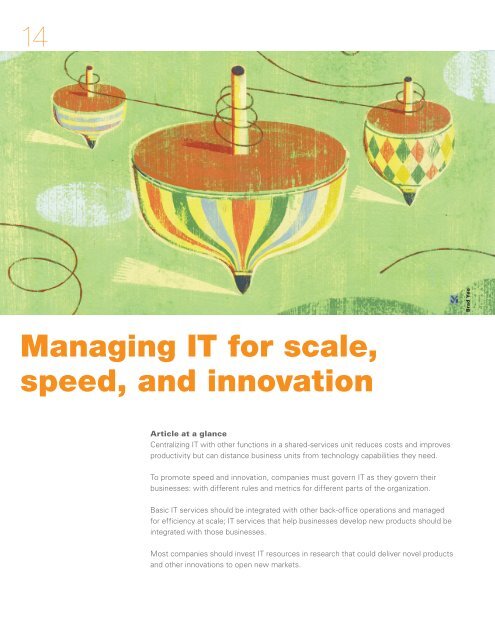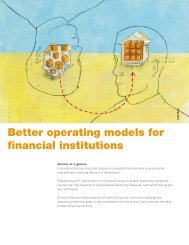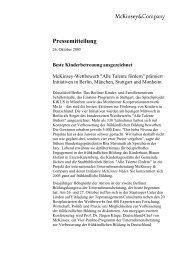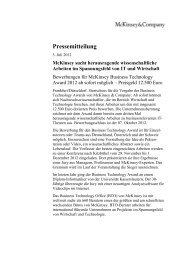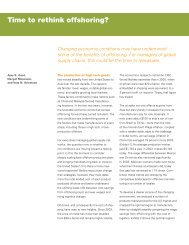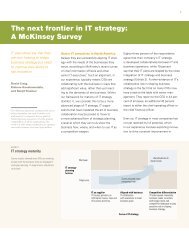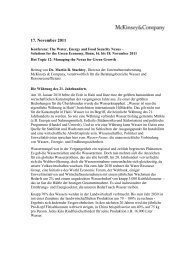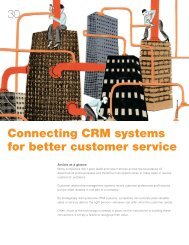Managing IT for scale, speed, and innovation - McKinsey & Company
Managing IT for scale, speed, and innovation - McKinsey & Company
Managing IT for scale, speed, and innovation - McKinsey & Company
Create successful ePaper yourself
Turn your PDF publications into a flip-book with our unique Google optimized e-Paper software.
14<br />
<strong>McKinsey</strong> on <strong>IT</strong> Fall 2006<br />
<strong>Managing</strong> <strong>IT</strong> <strong>for</strong> <strong>scale</strong>,<br />
<strong>speed</strong>, <strong>and</strong> <strong>innovation</strong><br />
Article at a glance<br />
Centralizing <strong>IT</strong> with other functions in a shared-services unit reduces costs <strong>and</strong> improves<br />
productivity but can distance business units from technology capabilities they need.<br />
To promote <strong>speed</strong> <strong>and</strong> <strong>innovation</strong>, companies must govern <strong>IT</strong> as they govern their<br />
businesses: with different rules <strong>and</strong> metrics <strong>for</strong> different parts of the organization.<br />
Basic <strong>IT</strong> services should be integrated with other back-office operations <strong>and</strong> managed<br />
<strong>for</strong> efficiency at <strong>scale</strong>; <strong>IT</strong> services that help businesses develop new products should be<br />
integrated with those businesses.<br />
Most companies should invest <strong>IT</strong> resources in research that could deliver novel products<br />
<strong>and</strong> other <strong>innovation</strong>s to open new markets.<br />
Brad Yeo
This article, part of a two-article<br />
package, examines the ongoing<br />
governance of <strong>IT</strong> in companies that<br />
differentiate among technology<br />
that supports, enhances, or changes<br />
the business model. A related<br />
article, “Divide <strong>and</strong> conquer:<br />
Rethinking <strong>IT</strong> strategy,” considers<br />
the strategic reasons <strong>for</strong> adopting<br />
this differentiated model.<br />
Sam Marwaha <strong>and</strong><br />
Paul Willmott<br />
1 For more on the limitations of governance<br />
structures, see Eric Monnoyer <strong>and</strong> Paul<br />
Willmott, “What <strong>IT</strong> leaders do,” <strong>McKinsey</strong><br />
on <strong>IT</strong>, Number 5, Fall 2005, pp. 2–6 (www<br />
.mckinseyquarterly.com/links/22556).<br />
Companies must govern <strong>IT</strong> as they govern their<br />
businesses: with different rules <strong>and</strong> metrics <strong>for</strong> different<br />
parts of the organization.<br />
The CIO of a large company with global operations faced a problem. The CEO had<br />
asked him to manage the company’s shared services <strong>for</strong> finance, human resources, <strong>and</strong><br />
procurement. On the one h<strong>and</strong>, the CIO thought it made sense to have one person in<br />
charge as the company st<strong>and</strong>ardized its back-office activities on a common enterprise-<br />
resource-planning (ERP) plat<strong>for</strong>m <strong>and</strong> moved some of them to low-cost locations.<br />
Such a program fit in well with the CIO’s advocacy of better integration between <strong>IT</strong> <strong>and</strong><br />
business functions. On the other h<strong>and</strong>, he was concerned that combining commodity<br />
services with in<strong>for</strong>mation technology would send the wrong message to the business units,<br />
since he had been urging them to view <strong>IT</strong> as a strategic function. He also worried that<br />
running back-office shared services in a strict <strong>and</strong> st<strong>and</strong>ard way, giving virtually no flexi-<br />
bility to the business units, would conflict with his goal of building a collaborative<br />
partnership with them in order to use technology to win in the marketplace.<br />
This CIO’s difficulty is becoming increasingly common. Leading companies are aggres-<br />
sively st<strong>and</strong>ardizing the back office globally, so they can operate efficiently <strong>and</strong> free<br />
business unit leaders to focus on getting products to market faster <strong>and</strong> commercializing<br />
them more effectively. These companies are also taking more risks, experimenting with<br />
ideas that will disrupt existing business models. This growing multiplicity of ways <strong>for</strong> <strong>IT</strong> to<br />
support strategies has exacerbated communication problems between <strong>IT</strong> <strong>and</strong> the business—<br />
problems that have long been a source of dissatisfaction <strong>for</strong> both sides. Traditional fixes<br />
such as governance bodies <strong>and</strong> processes are increasingly overengineered <strong>and</strong> don’t always<br />
deliver the hoped-<strong>for</strong> results. 1
<strong>McKinsey</strong> on <strong>IT</strong> Fall 2006<br />
Our work with companies in many sectors shows that the answer involves adopting what<br />
we call differentiated <strong>IT</strong> governance: integrating <strong>IT</strong> with the business area it supports<br />
<strong>and</strong> matching the management of <strong>IT</strong> to the management of the business. A few leading<br />
companies, <strong>for</strong> example, manage the in<strong>for</strong>mation technology that supports the global<br />
back office <strong>for</strong> <strong>scale</strong> while they manage the in<strong>for</strong>mation technology that supports frontoffice<br />
functions <strong>for</strong> <strong>speed</strong> <strong>and</strong> distinctiveness—with different leaders, structures, decisionmaking<br />
processes, skills, <strong>and</strong> incentives <strong>for</strong> each. In addition, these companies are searching<br />
<strong>for</strong> ways to manage <strong>IT</strong>-enabled business <strong>innovation</strong> apart from the rest of the business,<br />
using different metrics. (For a detailed description of how to set <strong>IT</strong> strategy around differ-<br />
entiation, see “Divide <strong>and</strong> conquer: Rethinking <strong>IT</strong> strategy,” in the current issue.)<br />
This new approach must also be dynamic: over time, cutting-edge <strong>IT</strong>-enabled business<br />
capabilities become commodity systems as rivals adopt them. <strong>Managing</strong> that migration is<br />
an additional challenge <strong>for</strong> executives. A few years ago, <strong>for</strong> instance, electronic data<br />
capture was a new <strong>for</strong>ce in the pharmaceutical sector, where it helped pioneering companies<br />
gain a competitive edge in clinical development. At the time, developers of these systems<br />
had to allow <strong>for</strong> customization. Today electronic data capture is more prevalent in the<br />
sector—a requirement to stay in the race—so companies must now focus on ensuring<br />
the use of off-the-shelf packages <strong>and</strong> st<strong>and</strong>ard, low-risk operations. Companies also need<br />
to be more proactive about migrating tasks from one category to another. While most<br />
technologies move downstream, from cutting edge to commodity, a few head in the opposite<br />
direction—<strong>for</strong> instance, when simple transactions can be analyzed more carefully to deliver<br />
new insights. At many companies, however, the interface between businesses <strong>and</strong> <strong>IT</strong> has<br />
become too complicated to ensure that these requirements are addressed as they change.<br />
Finally, while most companies have experience managing <strong>IT</strong> <strong>for</strong> efficiency or <strong>for</strong> <strong>speed</strong> <strong>and</strong><br />
business responsiveness, far fewer know how to harness <strong>IT</strong>-enabled business <strong>innovation</strong>s<br />
<strong>for</strong> competitive advantage. Without an adequate investment in <strong>innovation</strong>, companies can’t<br />
seed the front end of the technology cycle with ideas that will help them enter new busi-<br />
nesses or change the rules in existing ones.<br />
Align <strong>IT</strong> governance with the business<br />
The trend over the past decade to centralize <strong>IT</strong> has cut costs, strengthened compliance with<br />
corporate st<strong>and</strong>ards, simplified vendor management, <strong>and</strong> improved the way companies<br />
manage the dem<strong>and</strong> <strong>for</strong> <strong>and</strong> the delivery of their <strong>IT</strong> services. The downside is that these<br />
changes often distance technology from the business. Communication between business<br />
<strong>and</strong> technology leaders is often tightly structured to comply with new controls aimed at<br />
reducing waste <strong>and</strong> ensuring that everyone requesting <strong>IT</strong> services is treated equitably.<br />
When business executives grow less familiar with technology’s evolving capabilities <strong>and</strong><br />
technologists grow less familiar with the business, collaborative problem solving becomes<br />
more difficult. At one investment bank with pooled <strong>IT</strong> resources, <strong>for</strong> example, management<br />
found that the tech staff was losing touch with the bank’s current product offerings—<br />
a gap that lengthened the time needed to develop new products.<br />
Equally important, isolating <strong>IT</strong> makes it harder to leverage technology that could change<br />
the business model. Process <strong>innovation</strong>s enabled by new technologies frequently help
2 Back-office activities include operations such<br />
as accounting, basic applications support,<br />
billing, compensation, e-mail, inventory<br />
accounting, <strong>and</strong> security, which together<br />
typically account <strong>for</strong> 10 to 30 percent of a<br />
company’s cost base.<br />
<strong>Managing</strong> <strong>IT</strong> <strong>for</strong> <strong>scale</strong>, <strong>speed</strong>, <strong>and</strong> <strong>innovation</strong><br />
companies leap ahead of their competitors, but when <strong>IT</strong> is constrained too tightly, no<br />
funding is available <strong>for</strong> investment, <strong>and</strong> a risk-averse culture can develop. In some cases<br />
strict control backfires, encouraging in<strong>for</strong>mal back channels where rigid governance<br />
is circumvented <strong>and</strong> shadow <strong>IT</strong> organizations spring up. These developments occurred <strong>for</strong><br />
example, at a bank where managers were ignoring investment rules in order to finance<br />
new development projects, which in turn left vital regulatory projects without adequate<br />
budgets <strong>and</strong> behind schedule.<br />
Companies can avoid these problems <strong>and</strong> get more from their technology investments<br />
by ab<strong>and</strong>oning a one-size-fits-all mind-set <strong>for</strong> governance <strong>and</strong> adopting a model that lets<br />
three groups pursue different objectives while each group integrates with the business<br />
function it supports.<br />
Managed <strong>for</strong> <strong>scale</strong><br />
As more companies st<strong>and</strong>ardize their back-office business services 2 <strong>and</strong> try to reduce costs,<br />
they want <strong>IT</strong> to en<strong>for</strong>ce st<strong>and</strong>ards through ERP packages that implement common busi-<br />
ness policies throughout the organization. To do so, such companies typically put all of<br />
these functions, including <strong>IT</strong> support, under a leader with a track record <strong>for</strong> operational<br />
excellence—sometimes an <strong>IT</strong> leader who has driven a st<strong>and</strong>ardization ef<strong>for</strong>t <strong>and</strong> in other<br />
cases a business executive.<br />
By empowering a single leader to make investment decisions across <strong>IT</strong>, process redesign,<br />
training, <strong>and</strong> global sourcing, companies hope to reduce their back-office costs by 20 to<br />
40 percent over two to three years <strong>and</strong> then by 3 to 5 percent each year thereafter. Some<br />
of these savings may come from replacing a smorgasbord of existing legacy systems with<br />
a common plat<strong>for</strong>m, which can make maintenance less expensive <strong>and</strong> more reliable. As<br />
these back-office leaders st<strong>and</strong>ardize operations, they must balance the business’s need <strong>for</strong><br />
ease of use with their m<strong>and</strong>ate from the top to en<strong>for</strong>ce compliance. As a trade-off <strong>for</strong><br />
going along with the new program, business units save money on these services <strong>and</strong> can<br />
focus on winning in the marketplace.<br />
Rapid development <strong>for</strong> competitive advantage<br />
To create a competitive advantage, <strong>IT</strong> that helps business units win in their markets—by<br />
improving the <strong>speed</strong>, efficiency, or interface of products or by making it possible to<br />
develop new products rapidly—should be closely aligned with or embedded in the business<br />
group the <strong>IT</strong> supports. Decisions about <strong>IT</strong> investments should be based on whether they<br />
will confer an advantage in the marketplace; optimization ef<strong>for</strong>ts should aim to get new<br />
products or services into the market ahead of the competition.<br />
This approach works best when business unit leaders are as knowledgeable about deploying<br />
<strong>IT</strong> to win as they are about deploying capital or human resources. Raising the “<strong>IT</strong> IQ” of<br />
business leaders often delivers a significant payback. In addition, the <strong>IT</strong> leader supporting<br />
the business unit should be savvy enough about it to have insightful ideas on how <strong>IT</strong> can<br />
help it win. At one investment bank, <strong>for</strong> example, small specialist units of <strong>IT</strong> developers<br />
sit with front-office teams <strong>and</strong> report directly to them. Developers are reviewed <strong>and</strong><br />
compensated based on the success of the business.
<strong>McKinsey</strong> on <strong>IT</strong> Fall 2006<br />
<strong>IT</strong>-enabled business <strong>innovation</strong><br />
Even in industries where technology isn’t the business, new investments in it can have a<br />
rule-changing or disruptive effect. Applying the same investment barrier used by business<br />
units—that investments must be responsive to their needs—may lead companies to miss<br />
out on disruptive opportunities falling outside any particular unit. For that reason, some<br />
companies explore new <strong>innovation</strong>s outside of business units. These companies set<br />
up <strong>innovation</strong> groups where a higher level of risk is acceptable <strong>and</strong> managers often are<br />
measured on the value that success would generate. Even if only one in five experiments is<br />
robust enough to advance to the next stage, when a business unit leader takes responsibility,<br />
the <strong>innovation</strong> group might be considered successful.<br />
Migrating tasks from one level to another<br />
Although companies must differentiate the governance of each group by leadership, structure,<br />
decision-making rules, skills, <strong>and</strong> incentives, they must also coordinate across the groups<br />
to ensure that as a capability matures from cutting edge to commodity, it can be smoothly<br />
transferred from one group to another.<br />
Creating a mechanism <strong>for</strong> that purpose is just as important as setting up the proper<br />
governance <strong>for</strong> each group. Without such a mechanism, <strong>IT</strong> may go on investing too much<br />
in technologies that no longer confer any competitive advantage. That’s what happened<br />
at a consumer products company that continued to manage finance, procure-to-pay,<br />
<strong>and</strong> billing systems as if they provided a competitive differentiation long after they had<br />
become commodities. The company was spending over 30 percent more on these services<br />
than it had to—money that should have been invested in new areas to differentiate itself<br />
in the marketplace.<br />
Most companies tend to reexamine the way they manage their capabilities only during events<br />
such as mergers or cost-cutting programs. But the leading companies have a more proactive<br />
process to weigh capabilities annually <strong>and</strong> to shift them from one group to another.<br />
From <strong>innovation</strong> to business alignment<br />
Companies find different ways to determine when their <strong>IT</strong> investments in innovative,<br />
potentially disruptive technologies are ready to be managed by business units <strong>for</strong> competi-<br />
tive advantage. The most common approach is to make business leaders accountable <strong>for</strong><br />
commercializing the idea, while moving a cadre of technologists responsible <strong>for</strong> it into the<br />
appropriate business unit. The business then has to set top- <strong>and</strong> bottom-line goals <strong>for</strong> the<br />
contribution the idea should make to the company’s value. In some cases, the chief executive<br />
may create a new unit to commercialize the idea, particularly when it suggests a new<br />
business or product or threatens an existing business.<br />
We have seen other successful approaches as well. A media company per<strong>for</strong>ms an annual<br />
review of the technologies used by its competitors. A consumer products company created<br />
an internal <strong>innovation</strong> futures market, where managers can go long or short on innova-<br />
tive ideas pitched by the teams creating them. Once the market price of an idea crosses a<br />
threshold, the innovators get more funding; if it crosses a higher threshold, it’s transferred<br />
into an existing or new business unit. But if its price falls below a certain level, it gets killed.
New <strong>IT</strong> leadership<br />
roles<br />
Jamie Cattell <strong>and</strong><br />
Paul Willmott<br />
Jamie Cattell (jamie_cattell@mckinsey<br />
.com) is a consultant <strong>and</strong> Paul Willmott<br />
(paul_willmott@mckinsey.com) is a<br />
principal in <strong>McKinsey</strong>’s <strong>IT</strong> governance<br />
practice. Both are based in London.<br />
<strong>Managing</strong> <strong>IT</strong> <strong>for</strong> <strong>scale</strong>, <strong>speed</strong>, <strong>and</strong> <strong>innovation</strong><br />
As companies restructure <strong>IT</strong> to support differentiated<br />
roles (see “Divide <strong>and</strong> conquer: Rethinking <strong>IT</strong> strategy,” in<br />
the current issue)
0 <strong>McKinsey</strong> on <strong>IT</strong> Fall 2006<br />
Shared-services organizations are<br />
increasingly becoming a source of<br />
<strong>innovation</strong> on their own. See “Running<br />
a customer service center in India: An<br />
interview with the head of operations <strong>for</strong><br />
Dell India” (www.mckinseyquarterly<br />
.com/links/22693).<br />
From business alignment to <strong>scale</strong><br />
Similarly, businesses should evaluate whether their capabilities are still creating a<br />
competitive advantage or should be moved to shared services or otherwise managed <strong>for</strong><br />
<strong>scale</strong>. Some companies tie this evaluation to the annual budgeting process.<br />
Once a business decides to manage a capability <strong>for</strong> <strong>scale</strong>, there are at least three ways<br />
to migrate it. The most popular is to move its business processes, systems, <strong>and</strong> people into<br />
the <strong>scale</strong> organization <strong>and</strong> let them rationalize it. One company, <strong>for</strong> example, moved<br />
the bulk of the finance functions <strong>and</strong> systems embedded in various business units into a<br />
shared-services organization that uses a st<strong>and</strong>ard enterprise system. Another method,<br />
now becoming increasingly popular, is to create a st<strong>and</strong>ard capability within the <strong>scale</strong><br />
organization <strong>and</strong> to transfer the service incrementally, with the business unit responsible<br />
<strong>for</strong> redeploying or retiring the related systems <strong>and</strong> people. Finally, in corporate environ-<br />
ments where autonomy is strong or the technology behind the capability is already<br />
meshed tightly with <strong>scale</strong> operations, companies can apply budgetary constraints to the<br />
business unit <strong>and</strong> require it to con<strong>for</strong>m to <strong>scale</strong> st<strong>and</strong>ards <strong>and</strong> policies.<br />
From <strong>scale</strong> to business alignment or <strong>innovation</strong><br />
Most <strong>IT</strong> <strong>and</strong> business activities move over time from <strong>innovation</strong> to business alignment to<br />
<strong>scale</strong>, but occasionally the reverse is true. Many retailers, <strong>for</strong> example, now combine data<br />
from loyalty cards <strong>and</strong> transactions to underst<strong>and</strong> the individual consumer’s buying patterns.<br />
As a result, the collection, storage, <strong>and</strong> analysis of transaction data—once clearly <strong>scale</strong> func-<br />
tions—have become a competitive weapon <strong>and</strong> should be governed <strong>for</strong> business alignment.<br />
Companies need to ensure that they can spot these changes <strong>and</strong> transfer activities accordingly.<br />
A common signal is frustration on the part of the business with the <strong>scale</strong> organization’s<br />
flexibility <strong>and</strong> <strong>speed</strong> in specific capabilities. Migrating a business capability in this unusual<br />
upstream direction typically requires moving people from the <strong>scale</strong> group to newly created<br />
positions in the businesses.<br />
Strengthen <strong>innovation</strong> capabilities<br />
Most companies already have dedicated <strong>IT</strong> capabilities to carry out activities that help<br />
deliver a competitive advantage (win-the-race capabilities) or to manage technologies at<br />
<strong>scale</strong> (stay-in-the-race ones). Far fewer have strengthened their capabilities to change the<br />
rules in ways that their strategy might suggest. In many cases management hasn’t defined<br />
its aspirations <strong>for</strong> technology-led <strong>innovation</strong> or evaluated how well the current <strong>IT</strong> structure<br />
promotes them. In others the aspirations may be clear, but the companies haven’t agreed on<br />
the level of investment in capital <strong>and</strong> experienced talent needed to meet them. Sometimes<br />
the way companies manage <strong>innovation</strong> lacks accountability <strong>for</strong> results. The process of get-<br />
ting leaders to agree on the right level of investment can highlight a “reality gap”: the<br />
difference between what a company says it wants to accomplish <strong>and</strong> what it’s willing to<br />
invest. Four successful models are emerging <strong>for</strong> investments in <strong>innovation</strong>.<br />
1. Venture capital model. Some organizations rely on third parties to innovate <strong>for</strong> them,<br />
using strategic investments <strong>and</strong> acquisitions to gain access to new technologies <strong>and</strong> the<br />
associated business models. Usually a team of senior <strong>innovation</strong> leaders—executives with
New <strong>IT</strong> leadership roles<br />
high credibility, proven business <strong>and</strong> technology chops, <strong>and</strong> an appetite <strong>for</strong> risk—work<br />
together to identify <strong>and</strong> invest in these technologies <strong>and</strong> bring them into the company.<br />
Several telcos, <strong>for</strong> example, recently created such groups to find the capabilities that will<br />
shape the next generation of products.<br />
2. Innovation networks. Some players choose to tap wide-ranging external networks in<br />
academia, in hotbeds of start-up activity, <strong>and</strong> in their strategic <strong>IT</strong> vendors or partners.<br />
Ideas generated via this model are further developed by small internal teams <strong>and</strong> brought<br />
to a network of business leaders orchestrated by the CIO. (See “<strong>Managing</strong> <strong>innovation</strong>:<br />
An interview with BP’s CIO, John Leggate,” on page 10, <strong>for</strong> a description of BP’s<br />
approach to deploying such a model.)<br />
3. Innovation factory. Other companies create a separate organizational unit with a start-up<br />
atmosphere, where unstructured teams from business, <strong>IT</strong>, finance, <strong>and</strong> other disciplines<br />
work together to develop <strong>and</strong> evaluate innovative ideas. An investment bank, <strong>for</strong> example,<br />
has teamed its <strong>for</strong>mer CIO with a <strong>for</strong>mer business unit leader; they jointly run a new<br />
unit tasked with creating <strong>and</strong> delivering market-leading electronic services (<strong>for</strong> example,<br />
prime brokerage) to clients. Once services have proved their value to customers, the<br />
company transfers ownership of the plat<strong>for</strong>m to the relevant business group.<br />
4. Skunk Works. In banking <strong>and</strong> telecommunications, we’ve seen companies develop <strong>and</strong><br />
deploy new <strong>IT</strong>-enabled products <strong>and</strong> services from within existing <strong>IT</strong> organizations<br />
by setting up a small development unit headed by entrepreneurial technology leaders<br />
who underst<strong>and</strong> the needs of the business. At a telco whose CIO has a successful track<br />
record developing <strong>and</strong> deploying innovative products <strong>and</strong> services outside the company’s<br />
<strong>for</strong>mal processes, new solutions are tested in a small market. Those that succeed are<br />
then offered to the rest of the organization.<br />
All of these models require visionary <strong>and</strong> entrepreneurial leadership with deep knowledge<br />
of business <strong>and</strong> technology, as well as sponsorship from senior management—typically<br />
the CEO. Such sponsorship implies access to dedicated investment funding. In addition, a<br />
per<strong>for</strong>mance-management <strong>and</strong> incentive system that encourages appropriate risk taking<br />
holds the leaders accountable.<br />
In many companies CIOs struggle against the perception that their job is merely to keep<br />
the e-mail flowing. After all, CEOs know immediately when basic services fail but are less<br />
aware when investments in new technologies fall short or, even more problematic, when<br />
companies aren’t making the <strong>IT</strong> investments they need to refresh their businesses. By<br />
structuring <strong>and</strong> governing different aspects of <strong>IT</strong> to deliver on different goals, companies<br />
can be more confident that they are getting the most from their <strong>IT</strong> investments. Mo<strong>IT</strong><br />
Sam Marwaha (sam_marwaha@<br />
mckinsey.com) <strong>and</strong> Paul Willmott<br />
(paul_willmott@mckinsey.com)<br />
are principals in <strong>McKinsey</strong>’s global <strong>IT</strong><br />
practice <strong>and</strong> coleaders of the <strong>IT</strong><br />
governance <strong>and</strong> organization practice.<br />
Sam, who also leads the US pharma-<br />
ceutical <strong>IT</strong> practice, is based in<br />
New York, <strong>and</strong> Paul is based in London.<br />
Copyright © 2006 <strong>McKinsey</strong> &<br />
<strong>Company</strong>. All rights reserved.


